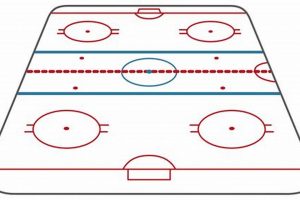This defensive strategy in ice hockey focuses on clogging the central area of the rink between the two blue lines. The primary objective is to impede the opposing team’s ability to transition smoothly from their defensive zone into the offensive zone. Instead of aggressively forechecking deep in the opponent’s end, the defending team positions its players strategically to create a wall, forcing turnovers or pushing the attacking team to the sides of the ice. A common implementation involves forwards retreating towards their own blue line, effectively reducing the available space and disrupting passing lanes.
The employment of this tactic can be highly effective in slowing down the pace of a game and limiting scoring opportunities for the opposing team. It prioritizes preventing high-quality scoring chances by forcing opponents to make difficult passes or to dump the puck into the offensive zone, allowing for easier retrieval by the defending team. Historically, its utilization has often been associated with teams that are either defensively-minded or seeking to protect a lead, providing a structured approach to limiting offensive pressure and controlling the game’s flow.
Understanding the intricacies of this defensive scheme is crucial for analyzing team strategies and appreciating the nuances of gameplay. The following sections will delve deeper into the specific player roles, tactical variations, and potential counter-strategies associated with this method of play. These detailed analyses will provide a more comprehensive understanding of its impact on the overall dynamics of the sport.
Strategic Implementation Guidance
The following guidelines detail effective practices associated with the deployment of this defensive strategy in competitive ice hockey.
Tip 1: Prioritize Player Positioning. Consistent and disciplined positioning within the designated zone is paramount. Players must maintain structured alignment to effectively block passing lanes and force opponents to the outside.
Tip 2: Emphasize Controlled Forechecking. Avoid aggressive deep zone forechecking. Instead, apply light pressure near the blue line to influence puck carrier decisions and channel them toward designated areas.
Tip 3: Focus on Intercepting Passes. Players should actively anticipate and intercept passes within the zone. This requires keen awareness and quick reactions to disrupt offensive plays before they develop.
Tip 4: Implement Quick Transitioning. Upon gaining possession, initiate a swift transition from defense to offense. Quick breakouts can capitalize on turnovers and create scoring opportunities.
Tip 5: Communicate Effectively. Clear and consistent communication among players is essential. Verbal and non-verbal cues ensure coordinated movement and prevent breakdowns in coverage.
Tip 6: Adapt to Opponent’s Strategies. Teams must be prepared to adjust their approach based on the opponent’s tactics. Flexibility is crucial for neutralizing different offensive schemes.
Tip 7: Practice Regularly. Consistent practice is necessary to reinforce proper positioning, timing, and execution. Repetition builds muscle memory and improves overall effectiveness.
Adherence to these principles maximizes the potential to control the neutral zone, limit opponent scoring chances, and generate offensive opportunities.
These guidelines provide a foundational understanding for successful implementation. The subsequent section will address common challenges and counter-tactics encountered when employing this approach.
1. Defensive Structure
Defensive structure is fundamental to the implementation of this specific strategy. It provides the framework for controlling the designated area of the ice and dictating the opponent’s offensive options. The efficacy of the trap hinges on a team’s ability to maintain a consistent and disciplined formation, effectively limiting space and disrupting the opposition’s transitional plays.
- Player Positioning and Alignment
This facet involves the predetermined arrangement of players within the zone. Players typically align themselves across the width of the ice, creating a layered barrier. This structure aims to deny the opposition central passing lanes and force them towards the boards. For example, a 1-3-1 formation is a common implementation, where one forward pressures the puck carrier, three players form a horizontal line to block the middle, and one player acts as a sweeper. The success of this positioning relies on consistent execution and adherence to the predetermined plan.
- Zone Coverage and Responsibility
Each player within the defensive structure is assigned a specific area of responsibility within the zone. This ensures comprehensive coverage and prevents gaps that the opposing team could exploit. For instance, one player might be responsible for covering the strong-side winger, while another is responsible for intercepting passes towards the center. Clear delineation of these responsibilities is essential for maintaining the integrity of the structure.
- Communication and Coordination
Effective communication is essential for maintaining a cohesive defensive structure. Players must communicate verbally and non-verbally to adjust to the flow of play and anticipate the opponent’s movements. For example, players might use verbal cues to signal a potential turnover or a shift in coverage responsibilities. This level of coordination requires significant practice and a deep understanding of the system.
- Adaptability and Adjustments
While a pre-determined structure provides a foundation, teams must be able to adjust their formation in response to the opponent’s tactics. This might involve shifting the defensive alignment to counter a specific offensive strategy or adjusting the pressure applied based on the game situation. For example, a team might transition from a passive to a more aggressive approach if they need to generate a turnover late in the game. Adaptability is key to long-term success in implementing this system.
These facets of defensive structure are interconnected and essential for effective implementation. By prioritizing player positioning, zone coverage, communication, and adaptability, teams can maximize their ability to control the designated area and disrupt the opponent’s transition. The strategic advantage gained through a well-executed defensive framework directly contributes to the overall effectiveness of this method.
2. Puck Retrieval
Puck retrieval is an indispensable component when employing the defensive strategy commonly referred to as the “ice hockey neutral zone trap”. Successful execution relies not only on disrupting the opposing team’s advancement, but also on gaining possession of the puck after forcing a turnover. Efficient puck retrieval ensures the transition from defense to offense, preventing prolonged defensive pressure and creating scoring opportunities.
- Anticipation and Interception
Anticipating the opposing team’s passes and intercepting them is a primary method of puck retrieval within this strategic framework. Players must read the play, anticipate passing lanes, and position themselves to intercept the puck as it enters the designated zone. For example, a defenseman anticipating a cross-ice pass and intercepting it before it reaches the intended target is a direct illustration of this facet. A successful interception immediately disrupts the opponent’s attack and provides an opportunity for a quick counterattack.
- Forced Turnovers and Loose Puck Recovery
The pressure exerted by the strategically positioned players often leads to forced turnovers. These turnovers result in loose pucks, which must be quickly recovered. Players must be alert and aggressive in pursuing these loose pucks, winning battles along the boards, and securing possession. A forward causing a turnover by pressuring the puck carrier, followed by the defenseman quickly securing the loose puck, is an example. Swift puck recovery minimizes the time spent in the defensive zone and maximizes transition opportunities.
- Controlled Clearing
In situations where immediate offensive transition is not feasible, controlled clearing becomes a critical aspect of puck retrieval. Instead of blindly shooting the puck down the ice, players aim to clear the puck strategically to a designated area, ideally where a teammate can gain possession. For instance, a controlled clearing pass along the boards to a supporting forward ensures that the puck is directed away from danger while maintaining a degree of possession. This method allows the team to regroup and initiate a more organized attack.
- Support and Positional Play
Effective puck retrieval requires coordinated support from all players on the ice. Players must position themselves strategically to provide passing options and support the puck carrier in the zone. For example, a winger skating back into the zone to support a defenseman retrieving a loose puck offers a viable outlet pass and prevents the opponent from regaining possession. This coordinated positional play ensures a smooth and efficient transition from defense to offense.
These facets demonstrate that successful puck retrieval is integral to the overall effectiveness. This method hinges on proactive anticipation, aggressive pursuit of loose pucks, strategic clearing techniques, and coordinated support from all players. A team that excels at these elements of puck retrieval can effectively disrupt the opponent’s offensive flow, control the designated area, and generate scoring opportunities. Therefore, puck retrieval should be regarded as essential as other elements to the success of that method.
3. Transition Disruption
Transition disruption constitutes a fundamental objective and consequence when employing the defensive strategy. The primary aim is to impede the opposing team’s ability to smoothly transition from their defensive zone through the central area and into the offensive zone. This disruption is achieved by strategically positioning players to create a congested area, effectively limiting passing lanes and hindering puck movement. For instance, if the attacking team attempts a breakout pass through the center of the ice, players aligned in formation are intended to intercept the pass or pressure the puck carrier, thus preventing the offensive advance. This direct interference with the opposing team’s transition is the core principle upon which the trap’s effectiveness is built.
The importance of transition disruption extends beyond simply stopping the immediate attack; it also influences the opponent’s tactical decisions. Faced with a consistently blocked central route, the attacking team may be forced to resort to less efficient strategies, such as dumping the puck into the offensive zone or attempting low-percentage plays along the boards. A real-world example can be observed in games where teams successfully employ this tactic, leading to a marked increase in turnovers and a decrease in the opposing team’s scoring opportunities. Furthermore, the consistent disruption of transitions can lead to frustration and fatigue among the opposing players, potentially causing them to make further mistakes and further reducing their offensive output.
In summary, transition disruption is inextricably linked to this specific defensive strategy. It serves as both the intended outcome and a critical tool for controlling the flow of the game. By effectively hindering the opponent’s ability to transition from defense to offense, a team employing the described system gains a significant strategic advantage, limiting scoring chances and dictating the pace of play. While challenges exist in consistently executing the scheme, the potential benefits of effective transition disruption underscore its central role in this defensive system.
4. Controlled Forecheck
The controlled forecheck is an integral component of this defensive strategy, influencing its overall effectiveness. The forecheck in this context is not an aggressive, deep-zone pursuit aimed at creating immediate turnovers. Instead, it serves as a method to guide and channel the puck carrier’s movements. This approach is less about directly winning possession in the offensive zone and more about influencing the opponent’s decisions, directing them toward predetermined areas of the ice, and ultimately disrupting their transition through the central area. A practical example involves a forward applying light pressure near the blue line, discouraging a direct attack through the middle and forcing the puck carrier towards the boards, where the defense is strategically positioned to intercept or contain.
The controlled forecheck supports the strategy by setting the stage for its implementation. By influencing the puck carrier’s trajectory, the forechecking player sets in motion a chain of events that lead to the desired outcome: a turnover or a stalled attack in the designated area. This controlled pressure ensures that the defense is not caught out of position by an overly aggressive forecheck. Rather, it allows the team to maintain its structured defensive formation, ready to capitalize on the predictable path of the puck. Consider a scenario where the opposing team attempts a quick breakout; a properly executed controlled forecheck can disrupt the timing, force a rushed pass, and create an opportunity for interception. The precision of the forecheck dictates the success in enacting the transition, which is essential in this scheme.
In essence, understanding the controlled forecheck’s function reveals a key insight: it’s not an isolated tactic but a carefully integrated element of a larger strategic framework. Without this disciplined approach, the defensive structure becomes vulnerable to penetration, and the intended control over the central area diminishes. Realizing its role is therefore crucial in implementing the defensive system. While the effectiveness of any strategy is dependent on execution and adaptability, it can be regarded as one of the cornerstones of this defensive system. The understanding and application of this connection are critical to the successful employment of this team approach.
5. Strategic Patience
Strategic patience is a defining characteristic of the defensive scheme. It dictates a measured approach, prioritizing defensive stability and controlled opportunities over aggressive, high-risk plays. This patience is not merely passive waiting; it represents a calculated decision to concede territory in exchange for limiting high-quality scoring chances and dictating the opponent’s offensive options.
- Disciplined Defensive Positioning
Maintaining disciplined positioning within the central area necessitates resisting the urge to over-commit to aggressive forechecking. Players must adhere to their designated zones and responsibilities, even when presented with enticing opportunities to pursue the puck deep in the opponent’s zone. This discipline ensures that the defensive structure remains intact, ready to capitalize on turnovers created by the opponent’s forced errors.
- Waiting for Forced Errors
Instead of actively seeking turnovers through aggressive challenges, this system relies on the opponent’s frustration and impatience to generate mistakes. By limiting passing lanes and forcing the opponent to make difficult plays, the defending team increases the likelihood of errant passes, turnovers, or pucks dumped into the zone. Strategic patience involves waiting for these inevitable errors and reacting decisively when they occur.
- Controlled Counter-Attacks
The transition from defense to offense is not initiated with reckless abandon but rather with a controlled and deliberate approach. Strategic patience dictates that counter-attacks be launched when the defensive structure is secure and the likelihood of success is high. This might involve waiting for a clear passing lane to develop or for the opponent to be caught out of position before committing players to the offensive rush.
- Resisting the Urge to Chase
The inherent frustration of preventing scoring in a fast-moving sport can push players to take aggressive or uncharacteristic action. However, this system requires an understanding and commitment to resisting this urge. This can create a stable and impenetrable defensive presence even in the later stages of the game. It is only through consistent resistance to external pressures that the advantages of the chosen defensive model can provide the intended competitive edge.
These elements of strategic patience are interconnected and essential for successful deployment. By emphasizing disciplined positioning, waiting for forced errors, initiating controlled counter-attacks, and resisting the urge to chase, a team can effectively control the neutral zone, limit scoring opportunities, and dictate the tempo of the game. While it may not always be the most visually exciting approach, it represents a calculated and potentially highly effective method for achieving long-term defensive success.
Frequently Asked Questions
This section addresses common inquiries regarding the implementation and implications of this defensive tactic in ice hockey.
Question 1: What are the core objectives of the neutral zone trap?
The primary objectives involve disrupting the opposing team’s transition through the central area, forcing turnovers, and limiting high-quality scoring opportunities.
Question 2: What player attributes are crucial for executing the trap effectively?
Key attributes include disciplined positioning, anticipation skills, strong skating ability, and effective communication among teammates.
Question 3: Does this tactic always result in a defensive or low-scoring game?
While the trap can slow down the pace, its primary aim is to control the central area and create counter-attacking opportunities, not necessarily to guarantee a low-scoring game.
Question 4: How does the forecheck relate to employing the trap?
A controlled forecheck, designed to guide the puck carrier towards designated areas, is generally preferred over an aggressive, deep-zone forecheck when utilizing this defensive strategy.
Question 5: What are some common strategies to counter the trap?
Effective counter-strategies include utilizing stretch passes, employing quick puck movement, and aggressively attacking the flanks to stretch the defensive formation.
Question 6: Is the use of this strategy considered unsportsmanlike?
The system, although sometimes criticized for slowing down the game, is a legitimate tactical approach within the rules of ice hockey and is not considered unsportsmanlike.
Understanding these key aspects offers a more comprehensive appreciation for its strategic implications.
The subsequent sections will delve deeper into common criticisms, alternate versions and effective means of play.
Conclusion
The preceding analysis clarifies the multifaceted nature of the ice hockey neutral zone trap. From its core principles of defensive structure and transition disruption to the nuanced roles of controlled forechecking and strategic patience, the trap presents a comprehensive approach to controlling the flow of the game. Its effectiveness hinges not only on a team’s ability to limit the opposition’s offensive opportunities but also on its capacity to capitalize on turnovers and initiate swift counter-attacks. While its utilization has been subject to debate and criticism, understanding its strategic implications is crucial for appreciating the complexities of tactical deployments in professional ice hockey.
Continued evaluation of evolving tactics and counter-strategies will determine the long-term viability of the ice hockey neutral zone trap. As offensive systems adapt and the game continues to evolve, a deeper understanding of its underlying principles remains essential for coaches, players, and analysts alike. Ultimately, the ongoing pursuit of innovation within the framework of strategic play will dictate the future of defensive systems and the overall dynamics of the sport.



![Shop European Ice Hockey Jerseys Online - [Team Name] & More! Your Ultimate Source for Hockey Updates, Training Guides, and Equipment Recommendations Shop European Ice Hockey Jerseys Online - [Team Name] & More! | Your Ultimate Source for Hockey Updates, Training Guides, and Equipment Recommendations](https://ssachockey.com/wp-content/uploads/2025/11/th-718-300x200.jpg)



